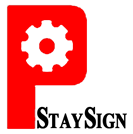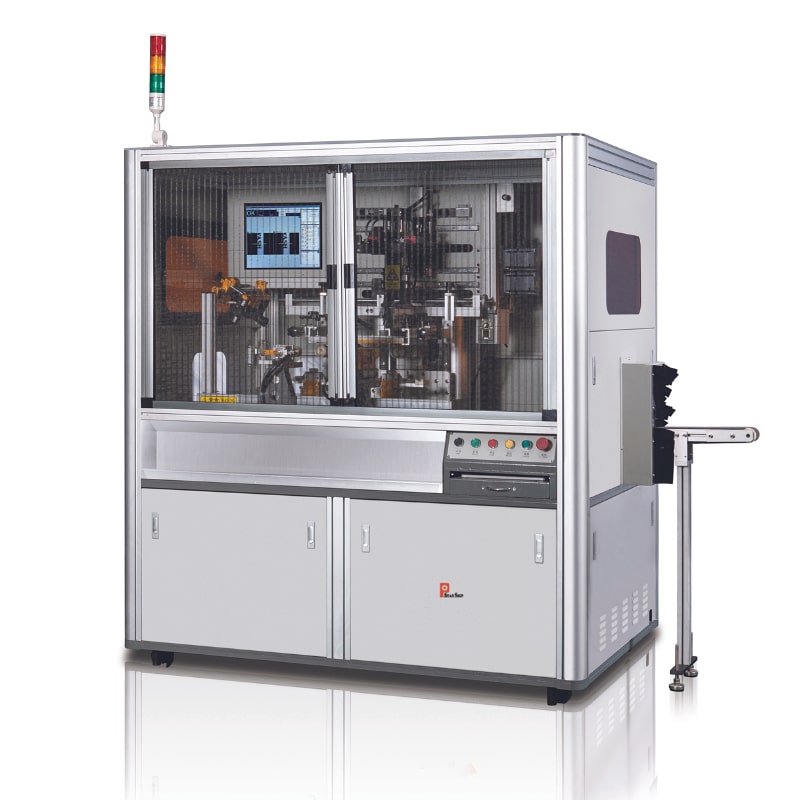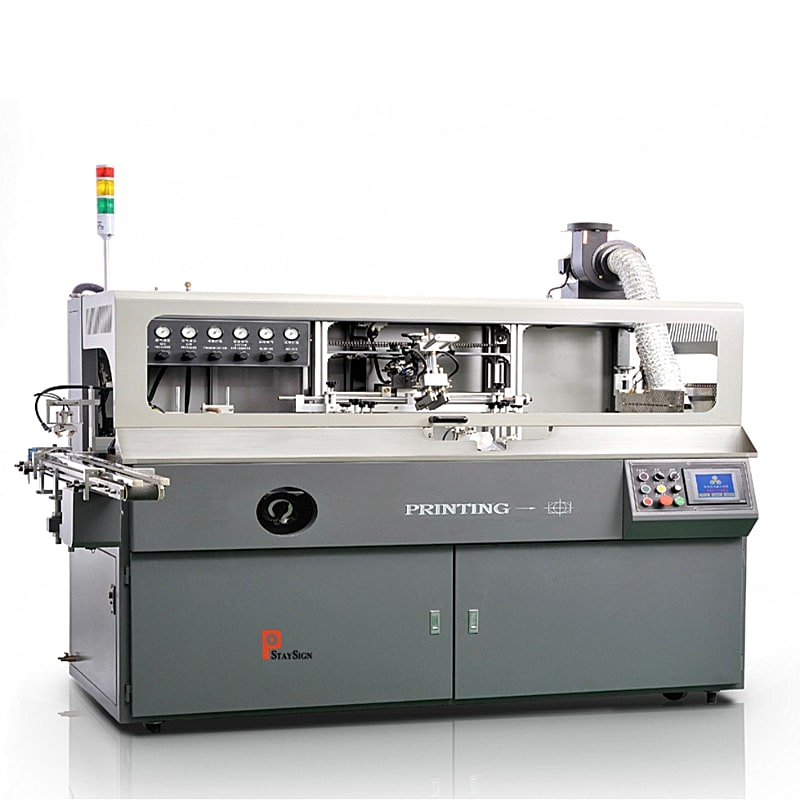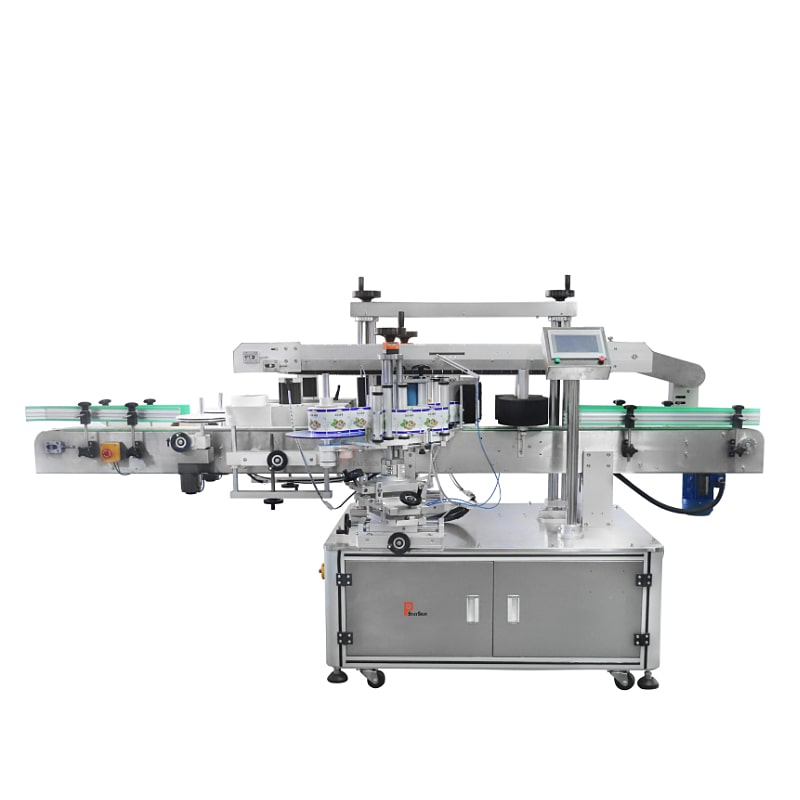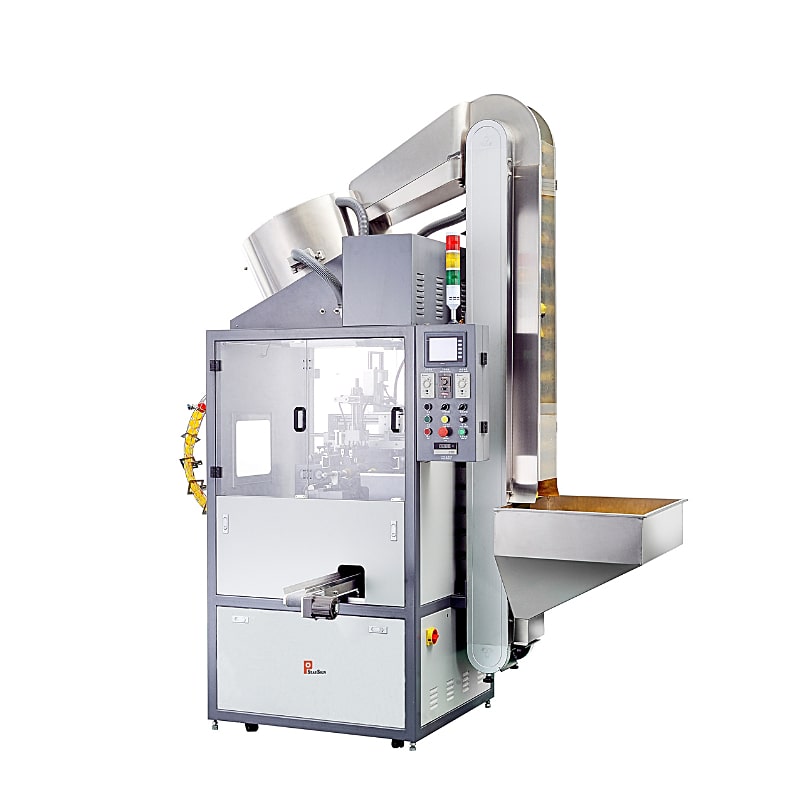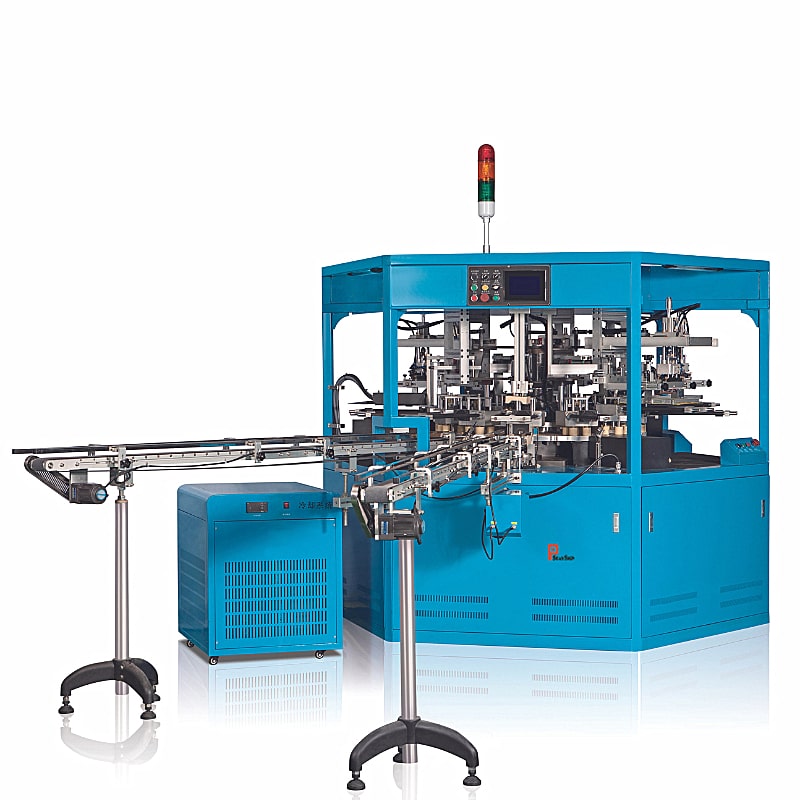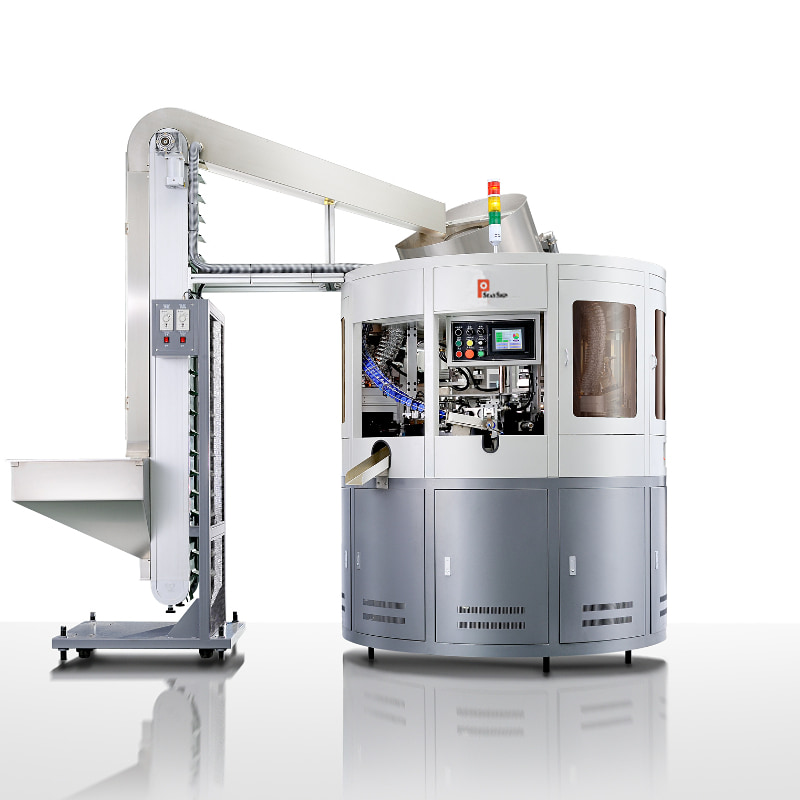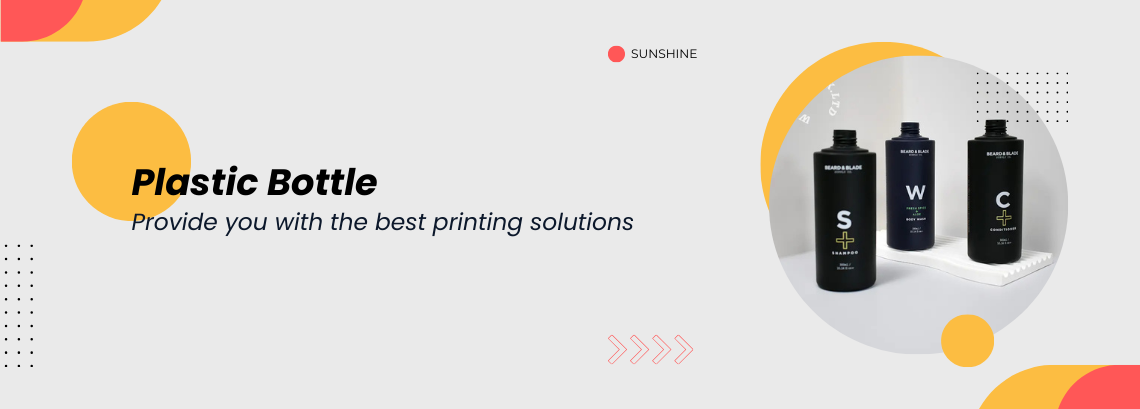
Plastic Bottle Printing Machine And Plastic Container Printing Solutions
Are you planning to start a printing business focused on plastic bottles or plastic containers? Or are you looking to upgrade to a better bottle printing machine to boost efficiency? Explore our selection of screen printing machines to find the perfect product for your business needs. We offer the latest plastic bottle printing machines of 2024 at cost-effective prices to support your business plans and projects.
At Sunshine, we provide a range of plastic container printing machines tailored to various applications. Our options include plastic water bottle printing machines, beverage bottle printing machines, juice bottle printing machines, soda bottle printing machines, and more. These machines enable full-color printing, gradient effects, textured finishes, variable data like names and numbers, and seamless full-surface coverage.
If you're interested, contact our printing experts to discuss the best screen printing solutions for your business.
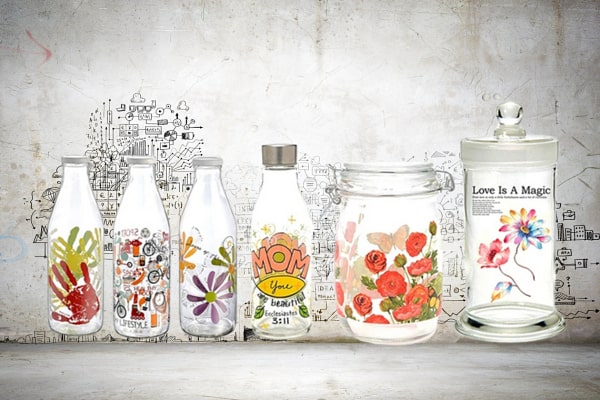
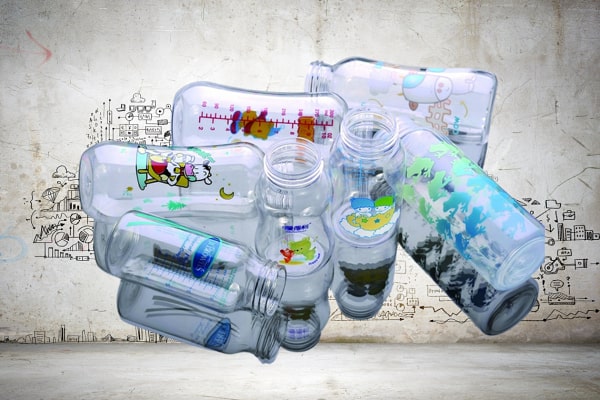
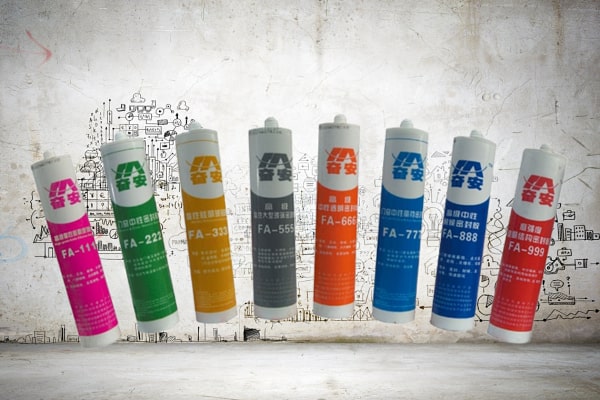
Types of Bottles for Plastic Bottle Printing Machines
| Bottle Type | Examples | Common Uses | Printing Needs |
|---|---|---|---|
| Water Bottles | PET water bottles | Personal and commercial use | Basic branding, logos |
| Beverage Bottles | Juice, soda, sports drinks | Beverage industry | Vibrant colors, branding |
| Cosmetic Bottles | Shampoo, lotion bottles | Personal care industry | High-quality, intricate designs |
| Pharmaceutical Bottles | Vitamin, supplement bottles | Healthcare industry | Clear labeling, dosage info |
| Detergent & Household Cleaner Bottles | Laundry detergent, dish soap | Household products | Durable labels, branding |
| Oil and Lubricant Bottles | Motor oil, cooking oil | Automotive and food industries | Durable and resistant printing |
| Milk and Dairy Product Bottles | Milk, yogurt containers | Dairy industry | Simple, durable labels |
Fully Automatic Plastic Bottle Printing Machine for Sale
Check out below Sunshine’s dedicated screen printing press for plastic bottleware
About the Advantages of Our Plastic Bottle Printing Machine
As a trusted manufacturer of plastic bottle printing machines, we offer distinct mechanical advantages that make our product stand out. Here's why our plastic bottle printing machine is the ideal choice for your printing needs:
- Solid Build: Our machine is crafted with robust materials and expert craftsmanship, ensuring durability and resilience in demanding production environments. With a sturdy construction and reliable components, our machine delivers consistent performance, minimizing downtime and maintenance hassles.
- Intuitive Operation: Designed with user-friendly features and intuitive controls, our plastic bottle printing machine is easy to operate, making it suitable for operators of all skill levels. With streamlined setup processes and simplified workflows, you can achieve efficient printing without unnecessary complexities.
- Flexible Functionality: Our machine offers versatility in printing applications, catering to a wide range of industries and product types.
Whether you're printing logos, labels, or intricate designs, our plastic bottle printing machine provides adaptable solutions to suit your specific requirements. From beverages to household products, our machine accommodates diverse printing needs with ease.
Plastic Bottle Printing Machine Price
| Basic Manual Machines | Semi-Automatic Machines | Fully Automatic Machines |
|---|---|---|
| Basic manual plastic bottle printing machines with limited features may start at a few thousand dollars. These machines often require manual operation for tasks such as loading cups, adjusting settings, and initiating the printing process. | Semi-automatic plastic bottle printing machines, which offer some level of automation in certain processes, can range from around $10,000 to $50,000 or more, depending on their capabilities and features. | Fully automatic plastic bottle printing machines, capable of handling larger production volumes with minimal manual intervention, can range from $50,000 to several hundred thousand dollars, depending on their production capacity, printing speed, and advanced features. |
Beginner’s Guide to Buying a Plastic Bottle Printing Machine
If you are a start-up and want to buy a printing machine for plastic bottle containers, then it is recommended that you read the content. It can help you better understand and choose screen printing machines
1. Introduction to Plastic Bottle Printing Machines
In today’s competitive market, printing on plastic bottles is more than just a finishing touch—it’s a powerful tool for branding, clear labeling, and regulatory compliance. Think about it: when customers grab a bottle off the shelf, what’s the first thing they notice? It’s the design, the colors, the information printed directly on the bottle. This makes printing essential not only for aesthetics but also for conveying product details, ingredients, safety warnings, and even expiration dates. So, if you’re looking to establish a presence in industries like beverages, cosmetics, or pharmaceuticals, a plastic bottle printing machine is a crucial investment.
Now, let’s dive into the different types of plastic bottle printing machines that can help meet these diverse needs. Each type of machine is designed to suit specific printing requirements, from durable silk screen printing on plastic bottles for vibrant, long-lasting designs, to digital printing that allows for complex graphics and variable data printing. Industries that rely on these printing solutions include everything from beverage bottling companies needing precise, colorful branding to pharmaceutical manufacturers requiring compliant, legible labels.
If you’re a beginner entering this space, you might wonder: Which machine is the right fit for your business goals? Choosing the right plastic bottle printing machine can make all the difference. It’s not just about getting a machine; it’s about finding one that aligns with your product type, printing needs, and production goals. As you’ll see in this guide, there’s a lot to consider, but getting it right will set you up for success and give you a strong competitive edge in the market.
2. Types of Printing Methods for Plastic Bottles
When it comes to printing on plastic bottles, choosing the right printing method is crucial to achieving the desired result for your product. Whether you’re focusing on branding, compliance, or enhancing the bottle’s appearance, the printing method you choose can have a big impact on the outcome. Below, we’ll explore the most common printing methods used for plastic bottles, each with its own unique benefits.
Silk Screen Printing on Plastic Bottles
One of the most popular and durable methods is silk screen printing on plastic bottles. This technique involves applying ink onto the surface of the plastic bottle through a screen that has a stencil of the design. The ink is then forced through the screen onto the bottle, creating a bold, vibrant image.
Advantages:
- Durability: Silk screen printing creates designs that are resistant to fading and wear, making it ideal for bottles that will be exposed to elements like sunlight, moisture, or handling.
- Color Vibrancy: The thick layers of ink used in silk screen printing produce bright, eye-catching colors that are perfect for bold branding and logos.
To achieve this, you'll need the right equipment, such as a plastic bottle screen printing machine or a plastic cap printing machine. These machines are specifically designed to handle the unique shapes and sizes of plastic bottles and caps, providing a high-quality print that lasts.
Digital Printing on Plastic Bottles
If flexibility and design complexity are your priorities, digital printing on plastic bottles might be the way to go. Unlike traditional methods, digital printing uses computer-controlled printers to apply ink directly to the bottle, similar to how an inkjet printer works on paper. This method is ideal for short runs, variable data printing, and intricate designs that would be difficult or time-consuming to achieve with other methods.
Advantages:
- Flexibility: Digital printing allows for rapid changes to designs and the inclusion of variable data, making it ideal for products that require customization.
- Design Capabilities: With digital printing, you can easily incorporate complex graphics, gradients, and even photographic images.
Inkjet printing on plastic bottles is a key method in digital printing. This type of printer uses high-resolution inkjets to apply detailed designs onto the surface, making it an excellent choice for beverage, cosmetic, and pharmaceutical companies that want to highlight fine details.
Laser Printing on Plastic Bottles
For high-end, durable, and long-lasting prints, laser printing on plastic bottles is an excellent option. Laser printing uses a focused laser beam to etch designs directly onto the plastic, which offers permanent and indelible marks. It’s commonly used for adding text, logos, or serial numbers to bottles in industries like pharmaceuticals and luxury products.
Advantages:
- High-Quality Marking: Laser printing produces sharp, clean marks that are easy to read and won’t fade over time.
- Durability: Because the laser etches directly into the material, it offers unparalleled durability, even in harsh conditions.
If you’re considering laser printing on plastic bottles, you would need a laser printer for plastic bottles. This specialized equipment is designed to handle the precision and heat required for laser engraving on plastic.
Inkjet Printing
Inkjet printing is another popular choice for batch coding, expiration dates, and MRP printing. This method is used to apply codes or dates to plastic bottles, ensuring compliance with regulatory standards in industries like food and beverage, cosmetics, and pharmaceuticals. Inkjet printing works by spraying microscopic droplets of ink onto the surface of the plastic bottle, which results in a fast, accurate, and cost-effective solution for marking bottles.
Advantages:
- Efficiency: Inkjet printing can quickly mark large batches of bottles, making it ideal for high-volume production lines.
- Versatility: It works well on curved or irregular surfaces, making it perfect for bottles of all shapes and sizes.
For inkjet printing, you’ll typically use an inkjet coder machine for plastic bottles, which is designed to print alphanumeric characters, barcodes, or logos. Additionally, MRP printing machines for plastic bottles are commonly used in the pharmaceutical industry to print manufacturing details and expiration dates on product packaging.
3. Factors to Consider When Choosing a Plastic Bottle Printing Machine
Click to Read More
When it comes to investing in a plastic bottle printing machine, there are several factors you need to consider to ensure you’re selecting the right equipment for your business needs. From production volume to the complexity of your designs, each element plays a role in determining the best printing machine for your situation. Below, we will dive into the key factors that should guide your decision-making process.
Production Volume
The expected daily/weekly output is a critical factor when choosing a plastic bottle printing machine. If you’re running a high-volume production line, you’ll need a machine capable of handling large quantities efficiently. Machines that can accommodate higher production rates are typically built for durability and speed, allowing you to meet the demands of large-scale production.
On the other hand, if you’re running a smaller operation or just starting, you may be able to get by with a machine designed for moderate output. Digital printing on plastic bottles is great for smaller batches with intricate designs, while traditional methods like silk screen printing on plastic bottles might be better for larger volumes with simpler designs.
Type of Design and Customization Needs
The type of design and level of customization you require will significantly influence the choice of printing machine. If your bottles need intricate, multi-color designs, silk screen printing or digital printing on plastic bottles may be more suitable.
-
Silk Screen Printing: Ideal for bold, simple designs with vibrant colors that need to stand the test of time. If your designs are repetitive and high in volume, plastic bottle screen printing machines are your go-to equipment.
-
Digital Printing: Perfect for highly detailed designs, including gradients, photos, and custom artwork. Inkjet printing on plastic bottles is a great option if you need the flexibility to change designs frequently or print variable data such as names, serial numbers, or batch codes.
Choosing the right machine to accommodate the level of customization you need is crucial. Laser printing on plastic bottles can also be an excellent choice for permanent marks, ideal for logos, serial numbers, or text that needs to be highly durable.
Bottle Materials
Different types of plastic bottles require different printing methods. The material of the bottle can impact the compatibility with certain printing methods. Common materials for plastic bottles include PET (Polyethylene Terephthalate), HDPE (High-Density Polyethylene), and PVC (Polyvinyl Chloride), and each of these plastics reacts differently to various printing techniques.
- Silk Screen Printing: Works well on most plastic surfaces, including PET and HDPE, giving a durable print that can withstand harsh conditions.
- Digital Printing: This method is often more adaptable, but it’s essential to ensure that the ink used is compatible with the plastic material to avoid poor adhesion or smudging.
- Laser Printing: Works well with most plastics, but it's especially ideal for bottles made from HDPE or PET as the high heat from the laser engraves the surface effectively.
When choosing a plastic bottle printing machine, consider the materials you will be printing on to ensure compatibility and optimal results.
Printing Speed
Printing speed is another important factor to consider. If your business involves high-speed production lines, you’ll need a machine that can print quickly without sacrificing quality. The speed at which a printing machine operates will directly affect your output and efficiency.
-
For high-volume operations, look for a machine with a fast printing speed like a laser printer for plastic bottles or a high-speed inkjet coder machine for plastic bottles. These types of machines are designed to keep up with rapid production demands.
-
On the other hand, if you’re working with lower volumes or custom orders, machines that offer more flexibility in terms of design, such as digital printing on plastic bottles, may be slower but offer better design versatility.
Assess your business’s speed requirements based on your production goals and select a machine that aligns with those needs.
Budget
One of the most significant factors in purchasing any machinery is the price. Plastic bottle printing machine prices vary widely based on the type of machine, its capabilities, and the complexity of the printing technology. Silk screen printing machines are typically more affordable upfront compared to more advanced options like digital printing machines or laser printers for plastic bottles, but they may have higher long-term operational costs due to maintenance and consumables.
-
Budget-Friendly Options: If you're just starting out or running a small operation, you might opt for more affordable printing methods like screen printing machine for plastic bottles.
-
Higher-End Options: If you need more flexibility and faster turnaround times, investing in a digital printing machine or laser printing machine might be a more expensive initial investment but could pay off with increased production efficiency.
It’s important to weigh the cost of the machine against the expected output, quality requirements, and long-term return on investment (ROI). Don’t forget to also factor in the cost of consumables, such as inks, screens, and maintenance.
Maintenance and Durability
Lastly, maintenance and the durability of your printing machine are essential to consider, especially if you plan to use the machine for continuous, long-term production. Machines that require frequent maintenance can cause significant downtime, leading to lost productivity and increased costs.
- Silk screen printing machines and inkjet printers for plastic bottles generally require regular upkeep to ensure optimal performance, but they are relatively straightforward to maintain with the right care.
- Laser printers may require specialized maintenance due to their intricate technology, and the cost of repairs can be higher.
When selecting your plastic bottle printing machine, consider not only the upfront cost but also the machine’s longevity and the frequency of required maintenance. Opting for machines with a solid warranty and service support can help mitigate maintenance concerns down the road.
4. Detailed Overview of Popular Plastic Bottle Printing Machines
When choosing the right plastic bottle printing machine, it’s essential to understand the capabilities, benefits, and limitations of each machine type. Different machines serve different needs, from screen printing to digital printing and specialized methods like inkjet printing and laser printing. Below, we’ll go over the most popular types of printing machines used for plastic bottles, providing you with the knowledge to make an informed decision.
Screen Printing Machine for Plastic Bottles
Key Features:
- Durability: Screen printing on plastic bottles is known for its durability and long-lasting prints. The prints resist fading, scratching, and wear, making it ideal for products that will be handled frequently or exposed to harsh conditions.
- High Quality: This method provides high-quality, vibrant prints, even for large designs with multiple colors.
- Versatility: Suitable for printing on various plastic materials, including PET and HDPE, screen printing can handle bottles of different shapes and sizes.
Benefits:
- Cost-Effective for High Volumes: Once the screens are set up, the machine can print large quantities at a low cost per unit. It’s a great option for businesses with high-volume needs.
- Color Vibrancy: Produces vibrant and rich colors, making it ideal for product branding.
- Long-Lasting Prints: The prints are highly durable and resistant to fading or peeling, which is crucial for maintaining a high-quality appearance.
Limitations:
- Limited Detail for Fine Designs: Although it’s fantastic for bold designs, screen printing on plastic bottles may not be ideal for highly detailed or intricate graphics. For complex designs, digital or inkjet printing on plastic bottles might be a better option.
- Setup Costs: The setup process involves creating screens for each color, which can be time-consuming and costly, especially for small runs.
Best Suited For:
- Businesses that need large volumes of printed bottles with relatively simple designs, such as beverage manufacturers, cosmetics companies, or cleaning products.
Digital Printing Machines
Key Features:
- Flexibility: Digital printing offers incredible flexibility, allowing you to print detailed, full-color designs without the need for screens or plates. You can print high-resolution graphics, logos, and even photos on plastic bottles.
- No Setup Fees: Unlike screen printing, there are no setup costs for creating screens or preparing ink for each color. Digital printing uses a single set of inks for all designs, making it perfect for custom prints.
- Quick Turnaround Time: Digital printing machines can produce prints in a matter of minutes, making them ideal for short runs or custom orders.
Benefits:
- Ideal for Customization: If you need to print variable data, such as batch numbers, expiration dates, or serial numbers, digital printing on plastic bottles can easily accommodate this. This method excels at producing personalized designs, even for small batches.
- Perfect for Intricate Designs: With digital printing, you can achieve highly detailed prints with fine lines, gradients, and multi-color logos.
Limitations:
- Higher Cost for Large Volumes: While digital printing machines are excellent for custom jobs and small runs, they tend to be more expensive when it comes to high-volume production.
- Print Durability: The prints may not be as durable as those produced by screen printing machines for plastic bottles, especially in environments where bottles will be subjected to heavy wear or chemicals.
Best Suited For:
- Small businesses or those requiring high customization, limited quantities, or intricate designs, such as startups or companies offering personalized products.
Inkjet Printers for Plastic Bottles
Key Features:
- High-Speed Printing: Inkjet printers for plastic bottles offer fast, non-contact printing. The machine prints the design directly onto the surface of the bottle without physically touching it, ensuring minimal wear and tear on both the bottle and the printer.
- Flexibility for Batch Coding: Ideal for printing expiration dates, MRP (Maximum Retail Price), batch numbers, and other variable data directly onto plastic bottles.
- Versatility: Inkjet printers can print on a variety of materials, including PET, HDPE, and PVC, making them versatile for different industries.
Benefits:
- Non-Contact Printing: Since the printer does not physically touch the bottle, there's less risk of contamination, making it a great option for industries like food and pharmaceuticals.
- High-Speed Production: Inkjet printing on plastic bottles can keep up with high-volume production lines, providing fast, reliable results.
- Cost-Effective for Small Batches: Inkjet printing is a cost-effective solution for printing expiration dates or serial numbers on bottles, particularly for industries with frequent updates to product batches.
Limitations:
- Limited Design Complexity: While inkjet printers can print text and simple graphics, they may not be the best choice for highly detailed or multi-color designs.
- Maintenance Requirements: Inkjet printers often require regular maintenance to prevent clogging and ensure optimal performance.
Best Suited For:
- Industries needing high-speed printing for batch coding, serial numbers, and expiration dates, such as pharmaceuticals, food, and beverage companies.
Laser Printers for Plastic Bottles
Key Features:
- Long-Lasting Prints: Laser printing on plastic bottles creates permanent, high-quality prints that are resistant to fading, scratching, and other forms of wear.
- Precision: Laser printers provide precise marking, making them perfect for applications where accuracy is crucial, such as in the pharmaceutical or electronics industries.
- Environmentally Friendly: Unlike other printing methods, laser printers don’t require inks or solvents, making them a more eco-friendly option.
Benefits:
- Durable, Abrasion-Resistant Marks: Laser printers for plastic bottles are ideal for producing long-lasting marks that won’t wear off over time, making them perfect for products exposed to tough conditions or frequent handling.
- High Precision: If you need to engrave logos, barcodes, or other small, intricate details onto plastic bottles, laser printing is the most precise method available.
Limitations:
- Higher Initial Cost: Laser printers tend to be more expensive than other types of printing machines, which can be a consideration for smaller businesses with tighter budgets.
- Not Ideal for Large Designs: While laser printers excel at small, detailed marks, they may not be the best choice for printing large designs or multi-color artwork.
Best Suited For:
- Businesses that need precise, durable markings on products, particularly those in the electronics, pharmaceutical, or high-end cosmetic industries.
Specialty Machines
Date Printing Machine on Plastic Bottles
Key Features:
- Dedicated to Date Marking: These machines are designed specifically to print expiration dates, batch numbers, and MRP (Maximum Retail Price) directly onto plastic bottles.
- High-Speed and Accuracy: Date printing machines for plastic bottles offer fast, accurate printing that’s easy to integrate into high-speed production lines.
Benefits:
- Critical for Compliance: Date printing is crucial for compliance with regulations in industries such as food, beverages, and pharmaceuticals. These machines ensure that all printed data is accurate and legible.
- Cost-Effective for Small and Large Runs: Date printers are typically affordable and can handle both low and high-volume production.
Limitations:
- Limited Design Options: These machines are highly specialized and can only print date-related information, meaning they’re not suitable for complex branding or logo printing.
Best Suited For:
- Companies in the food, beverage, and pharmaceutical industries that need to print expiration dates and other compliance-related information.
5. Cost Analysis: What Influences Plastic Bottle Printing Machine Price?
When it comes to purchasing a plastic bottle printing machine, price is one of the most important factors to consider. The cost of these machines can vary significantly based on several factors, and understanding what influences the price will help you make a more informed decision. Below, we’ll break down the key elements that affect the cost of plastic bottle printing machines and provide tips on how new buyers can balance price with performance.
1. Technology Type (Screen, Digital, Laser, Inkjet)
The type of printing technology used in a machine plays a significant role in determining its price. Let’s explore how different technologies impact costs:
-
Screen Printing Machines: Typically, screen printing on plastic bottles is one of the more affordable options, especially for high-volume production. However, the initial setup can be costly due to the need for specialized screens and ink. These machines are often favored for their durability and efficiency in large runs but may have higher operating costs for smaller jobs. Expect a moderate upfront investment.
-
Digital Printing Machines: Digital printing on plastic bottles tends to be more expensive because of the flexibility and high-resolution printing it offers. Digital machines allow for intricate designs, variable data (like serial numbers or expiration dates), and quick turnaround times. While the initial investment can be high, digital printing machines are ideal for businesses that need customization or work with smaller volumes.
-
Laser Printing Machines: Laser printers for plastic bottles are generally the most expensive option. The precision, durability of the prints, and eco-friendliness make laser printers a top choice for high-end applications where permanence and accuracy are key. They tend to have high initial costs but offer low long-term operating costs since no inks or solvents are required.
-
Inkjet Printers: Inkjet printing on plastic bottles is a flexible and cost-effective choice for batch coding, expiration dates, and product markings. Inkjet printers for plastic bottles are typically affordable in terms of initial cost but may require more maintenance and operational costs, especially in high-speed production environments.
6. Step-by-Step Guide to Buying the Right Machine
Choosing the right plastic bottle printing machine is a crucial decision for any business looking to enhance its branding, labeling, or compliance efforts. For beginners, navigating the wide variety of available machines can be overwhelming, but by following a step-by-step guide, you can make an informed choice that suits your needs and budget. Here's a practical guide to help you through the process:
1. Assessing Your Printing Needs and Goals
Before diving into the details of different plastic bottle printing machines, the first thing you need to do is clearly define your printing needs. This step will serve as the foundation for the entire decision-making process.
-
Production Volume: Start by determining how many bottles you need to print each day or week. A screen printing machine for plastic bottles may be ideal for large, high-volume productions, while a digital printing machine might be more suitable for smaller batches or customization needs.
-
Design Requirements: Consider the complexity of your designs. If you plan to print intricate logos, detailed artwork, or multi-colored designs, a digital printer or silk screen printing machine would be better than a simpler inkjet printer for plastic bottles.
-
Material Compatibility: Different plastic bottle printing machines work better with certain types of plastics. For example, laser printing on plastic bottles is great for certain plastics that need high-quality, durable marks, while inkjet printing might be more appropriate for batch coding or date printing.
-
End Use: Think about the type of industry you're in. For beverages, date printing machines on plastic bottles may be necessary to include expiration dates, while for cosmetics, plastic cap printing machines might be required to print branding on smaller caps.
2. Researching Machine Types and Features
Once you have a clear understanding of your printing needs, it’s time to explore the different plastic bottle printing machines available and compare their features.
-
Screen Printing Machines: If you're looking for durability and vibrant colors, silk screen printing on plastic bottles is a great option. These machines are particularly good for large volumes of simple designs and can print on a variety of bottle shapes and sizes. Look for features like automatic feeding, multi-color printing, and easy setup.
-
Digital Printing Machines: Digital printing on plastic bottles is ideal if you need flexibility in your designs or have small batch production. These machines can handle complex artwork and variable data, such as serial numbers or barcodes. Features to look for include high resolution, fast drying times, and the ability to print on different materials.
-
Laser Printers: Laser printing on plastic bottles is known for creating precise, permanent marks without the use of ink. This technology is often used for high-end products and industries where durability is key. When researching laser printers, focus on their ability to handle various bottle materials and the speed at which they can operate.
-
Inkjet Printers: If you need inkjet printing on plastic bottles, look for machines that offer fast, non-contact printing for high-speed production lines. Features like adjustable print heads and the ability to print on curved surfaces can be crucial in these printers.
-
Specialty Machines: For specific needs like MRP printing machine for plastic bottles or date printing machine on plastic bottles, check for machines that are tailored for batch coding, expiration dates, and regulatory compliance.
3. Comparing Models and Prices
Now that you've narrowed down your options based on your needs and the types of machines, it’s time to compare models and prices. Pricing can vary significantly based on the machine’s technology, features, and brand, so it’s important to do your homework.
-
Set a Budget: Determine how much you're willing to spend, not just on the initial machine but also on consumables (such as ink, screens, or lasers) and ongoing maintenance.
-
Price vs. Features: Higher-priced machines often offer more advanced features such as faster printing speeds, automation, and better durability. While it may be tempting to go with a lower-cost option, remember that you might sacrifice efficiency or print quality in the long run.
-
Brand Reputation: Look for reputable manufacturers who offer high-quality plastic bottle printing machines. Sometimes, paying a little extra for a well-known brand can provide you with better performance, longer-lasting equipment, and superior customer support.
-
Review Specifications: Pay attention to key specifications like print speed, resolution, customization capabilities, and machine dimensions. Make sure the machine you're considering fits your production space and meets your needs for both speed and quality.
4. Understanding Warranty, Support, and Training Options from Suppliers
Choosing the right machine isn’t just about the price and features—it’s also about the long-term support you’ll get from the supplier. Consider the following before making your final decision:
-
Warranty: Ensure that the plastic bottle printing machine comes with a solid warranty that covers both parts and labor. A good warranty will give you peace of mind knowing that if something goes wrong, you won’t be left with expensive repairs.
-
Technical Support: Look for suppliers that offer reliable customer support and technical assistance. If your machine malfunctions or requires maintenance, you want to be able to get help quickly without long downtime.
-
Training Options: If you're new to printing machines, consider whether the supplier offers training services to help you and your team get up to speed. Some suppliers provide on-site training or online tutorials to ensure you’re using the machine correctly and efficiently.
-
Post-Sale Support: It’s also important to check if the supplier offers ongoing maintenance, service plans, or spare parts availability. This can be essential to ensure your machine stays in good working condition and operates at peak performance for years.
7. Maintenance Tips for Plastic Bottle Printing Machines
Maintaining your plastic bottle printing machine properly is essential to keeping it in top working order and ensuring consistent, high-quality prints. Regular maintenance can not only extend the lifespan of the machine but also improve its performance, reduce downtime, and avoid costly repairs. Here’s a breakdown of key maintenance practices to help keep your machine running smoothly.
1. Regular Cleaning
Keeping your machine clean is one of the simplest but most important steps in maintenance. Plastic bottle printing machines accumulate ink residue, dust, and debris, which can affect print quality and cause wear on components.
-
Daily Cleaning: Clean the printing heads, rollers, and nozzles daily, especially after heavy use. Inkjet and screen printing machines for plastic bottles are particularly prone to ink buildup, so make sure to clean these parts carefully.
-
Scheduled Deep Cleaning: Perform a thorough cleaning of the entire machine, including internal components, on a weekly or monthly basis. This helps remove stubborn residue that daily cleaning might miss and ensures the machine continues to operate efficiently.
2. Calibration and Adjustment
Over time, even the best machines can start to lose calibration, which affects print alignment and quality. Regular calibration ensures that your machine delivers sharp, accurate prints every time.
-
Check for Alignment Issues: If you notice misaligned prints or faded sections, it’s likely time to recalibrate. Most machines have built-in calibration settings that can be adjusted according to the type of print job or materials you’re using.
-
Adjust Print Settings: Some machines allow you to adjust settings for different types of plastics or designs. Make sure to refer to the manual for instructions on adjusting settings specific to your plastic bottle printing machine to optimize its performance.
3. Software and Firmware Updates
Modern printing machines often come with software to control operations and manage print jobs. Updating this software ensures you have access to the latest features, fixes, and performance enhancements.
-
Check for Updates Regularly: Manufacturers may release software or firmware updates to improve machine stability and add new features. Checking for updates monthly and installing them as they become available can help your machine stay up-to-date.
-
Recalibrate After Updates: Major software updates may change the way your machine operates, so it’s always a good idea to recalibrate the machine afterward. This ensures that new updates don’t disrupt print quality.
4. Monitor and Replace Parts as Needed
Printing machines have various parts, such as print heads, rollers, and filters, that can wear out over time. Regularly inspect these parts for signs of wear and replace them when necessary.
-
Inspect Print Heads and Rollers: Print heads in inkjet printers for plastic bottles and rollers in screen printers are high-wear components. If you notice inconsistent print quality, check these parts first.
-
Change Filters and Lubricate Moving Parts: Machines that run continuously can accumulate dust in filters and require lubrication on moving parts. Replacing filters regularly and ensuring parts are lubricated can prevent mechanical issues.
5. Store Inks and Materials Properly
For machines that use ink, such as screen printing machines and inkjet coders for plastic bottles, it’s crucial to store inks and consumables correctly.
-
Keep Inks at Optimal Temperature: Extreme temperatures can affect the viscosity and quality of inks. Store inks in a cool, dry place to ensure consistent print quality.
-
Avoid Expired Ink: Using expired ink can clog nozzles and affect print quality. Always check the expiration dates on your inks and replace them as needed.
6. Establish a Routine Maintenance Schedule
Setting up a routine maintenance schedule helps ensure you don’t overlook essential tasks. Many businesses find that a weekly or monthly maintenance checklist helps keep machines in top condition.
-
Daily Tasks: Basic cleaning, checking ink levels, and quick visual inspections for any loose parts or debris.
-
Weekly Tasks: Deep cleaning, calibration checks, and lubrication of moving parts.
-
Monthly Tasks: Software update checks, in-depth inspections for wear and tear, and filter replacements as needed.
Benefits of Proper Maintenance
Investing time in regular maintenance has several long-term benefits:
-
Extended Lifespan: Proper upkeep ensures your machine lasts longer, protecting your initial investment.
-
Consistent Print Quality: Regular calibration and cleaning prevent common issues like misalignment, faded prints, and ink smudges.
-
Reduced Downtime: Preventative maintenance minimizes unexpected breakdowns and costly repairs, keeping your production schedule on track.
Maintaining a plastic bottle printing machine may seem time-consuming, but these steps pay off by ensuring reliable performance and prolonging the machine’s life. By integrating these tips into your regular workflow, you can maximize your printing machine's efficiency, save on repair costs, and consistently produce high-quality prints.
8. Frequently Asked Questions (FAQs)
For beginners entering the world of plastic bottle printing machines, it's natural to have questions about the different printing methods, durability, and which machine best suits specific needs. Here are answers to some of the most common questions to help clarify the basics and guide your buying decisions.
1. What’s the Difference Between Screen Printing and Digital Printing on Plastic Bottles?
Screen Printing involves pushing ink through a fine mesh stencil to create designs on the surface. This method is known for its vibrant colors and durability, especially useful for logos and simple graphics that need to withstand heavy use.
Digital Printing, on the other hand, prints images directly onto the bottle surface using digital technology. It's ideal for detailed designs and high-resolution images and allows for quick changes between designs without the need for new stencils. Digital printing is generally more flexible but may not be as long-lasting as screen printing for certain applications.
2. How Long Do Printed Designs Last on Plastic Bottles?
The lifespan of printed designs depends on the printing method and the environment the bottle is used in. Here’s a general breakdown:
-
Screen Printing: Known for excellent durability, screen-printed designs can last for years without fading or wearing off. This is especially true for bottles exposed to water, UV light, or abrasion.
-
Laser Printing: Laser-engraved designs are typically permanent, as they involve etching the design onto the bottle's surface, making it resistant to fading or scratching.
-
Inkjet Printing: Commonly used for batch numbers and expiration dates, inkjet printing may fade more quickly, especially in high-moisture or high-temperature environments.
-
Digital Printing: While detailed and high-quality, digital prints can be less resistant to heavy wear and may fade over time if exposed to rough handling or environmental factors.
3. Which Printing Machine is Best for MRP Printing on Plastic Bottles?
For MRP (Maximum Retail Price) printing and batch coding, inkjet coder machines for plastic bottles are widely used. Inkjet printers are fast, non-contact, and can easily print variable data, such as dates, prices, and batch numbers, with precision. This type of printing machine is commonly found in production lines across industries where high-speed, small-scale text printing is essential.
4. How Does Laser Printing Compare to Inkjet Printing for Plastic Bottles?
Laser Printing offers high-quality, permanent markings that are resistant to abrasion, chemicals, and UV light. It's ideal for applications where long-lasting, indelible marks are required, such as branding logos or serial numbers.
Inkjet Printing, on the other hand, is faster and more affordable, making it suitable for applications that require variable data, such as expiration dates, batch numbers, and MRP details. However, inkjet prints are generally less durable than laser markings, especially in environments with exposure to moisture or abrasion.
5. Can I Print on Different Types of Plastics with the Same Machine?
Most plastic bottle printing machines are versatile and can print on various types of plastic, including PET, HDPE, LDPE, and PP. However, the quality and adhesion of the print can vary based on the type of plastic and printing method. It's essential to check compatibility with your supplier and conduct tests on different materials to ensure optimal results.
6. Are Plastic Bottle Printing Machines Difficult to Maintain?
Maintaining a plastic bottle printing machine isn’t difficult but does require regular attention. Basic maintenance tasks, such as cleaning the print heads, calibrating settings, and updating software, are generally straightforward. Keeping a routine maintenance schedule helps improve the machine’s lifespan and reduces the risk of costly repairs.
7. What Should I Look for When Choosing a Plastic Bottle Printing Machine?
When selecting a plastic bottle printing machine, consider the following factors:
- Production Volume: Ensure the machine can handle your expected output.
- Print Quality: Choose a machine that delivers the level of detail and durability needed.
- Printing Method: Select a method (screen, laser, inkjet, or digital) based on the type of designs and materials.
- Budget: Balance cost with performance and durability for long-term value.
These questions and answers offer insight into key considerations for beginners in the plastic bottle printing industry. Understanding the different printing methods, maintenance requirements, and specific applications will help you choose the right machine to match your production goals.
9. Conclusion
Choosing the right plastic bottle printing machine can be a game-changer for any business in industries like beverages, cosmetics, pharmaceuticals, and beyond. As we’ve explored in this guide, there are various printing methods—such as screen printing, digital printing, laser printing, and inkjet printing—each offering unique benefits tailored to different business needs.
For beginners, understanding these options, along with factors like production volume, budget, and machine maintenance, is essential to making an informed investment. Not only will selecting the right machine improve efficiency and brand appeal, but it will also help meet both current and future business requirements as you grow.
When in doubt, reach out to industry experts or consult trusted suppliers who can guide you on the best machine type for your specific goals. With the right knowledge and support, investing in a plastic bottle printing machine can be a seamless step toward enhancing your production capabilities and expanding your brand's reach.
Related content recommendation
Customize Plastic Bottle Printing Machine/Line for Your Business
- Understand your business needs
We first take the time to understand your needs and well. This helps us determine the type of plastic bottle printing machine best suited for your desired application and advise you accordingly.
- Determine the specifications of the machine
We also understand your product throughput requirements to ensure we have the right machine capacity for efficient applications.
- Choose the perfect machine size for your plant
Finally, we review the space and layout of your base of operations to ensure we can accurately size the machine.
Please contact your Sunshine sales engineer to help you choose the best plastic bottle printing machine for your printing business. Combining our products and services can help your packaging printing business gain more profits for many years.
Want the Lowest Price Plastic Bottle Printing Machine?
Click the button to contact us, you will get free solutions, expert guidance, and the latest quotation
